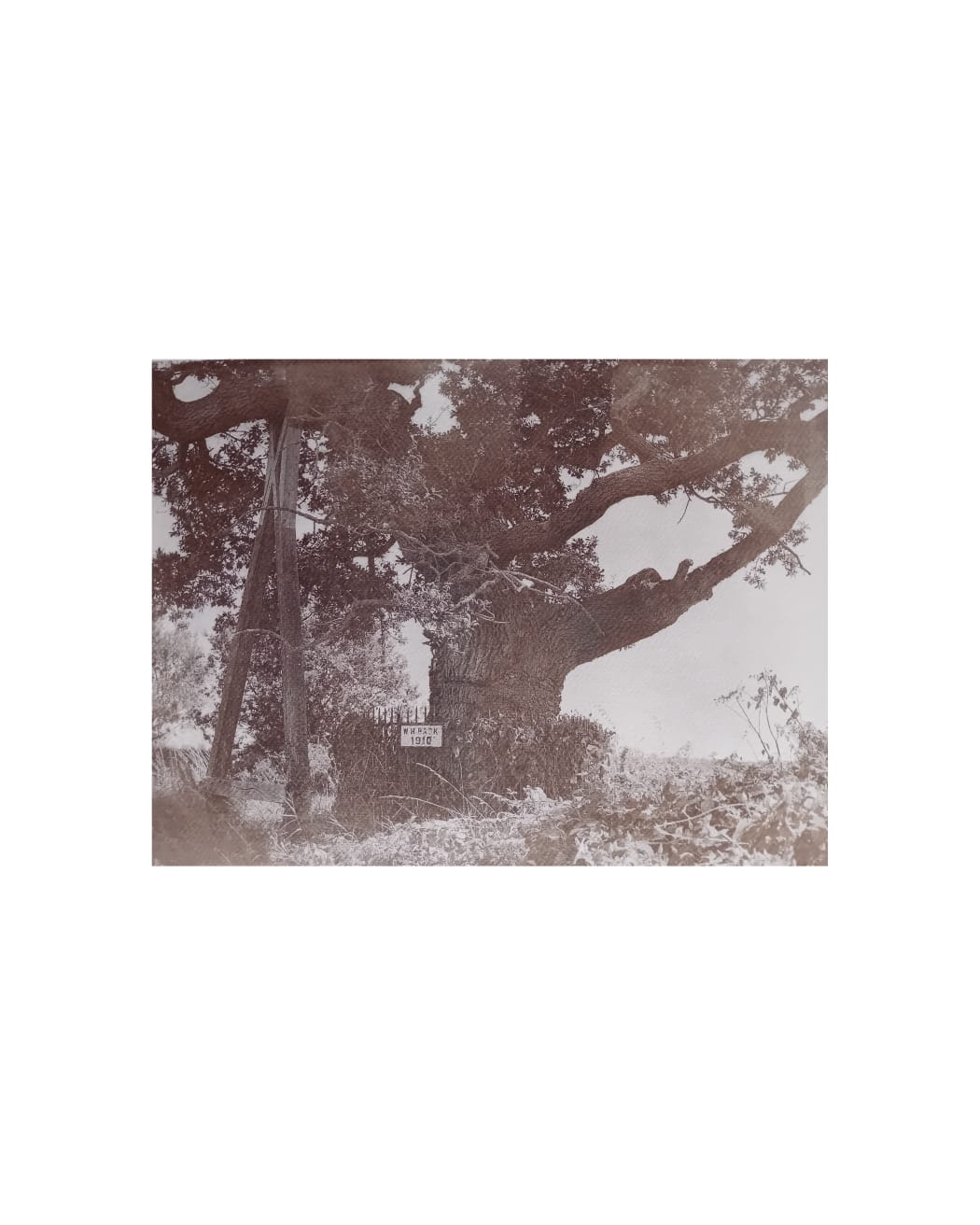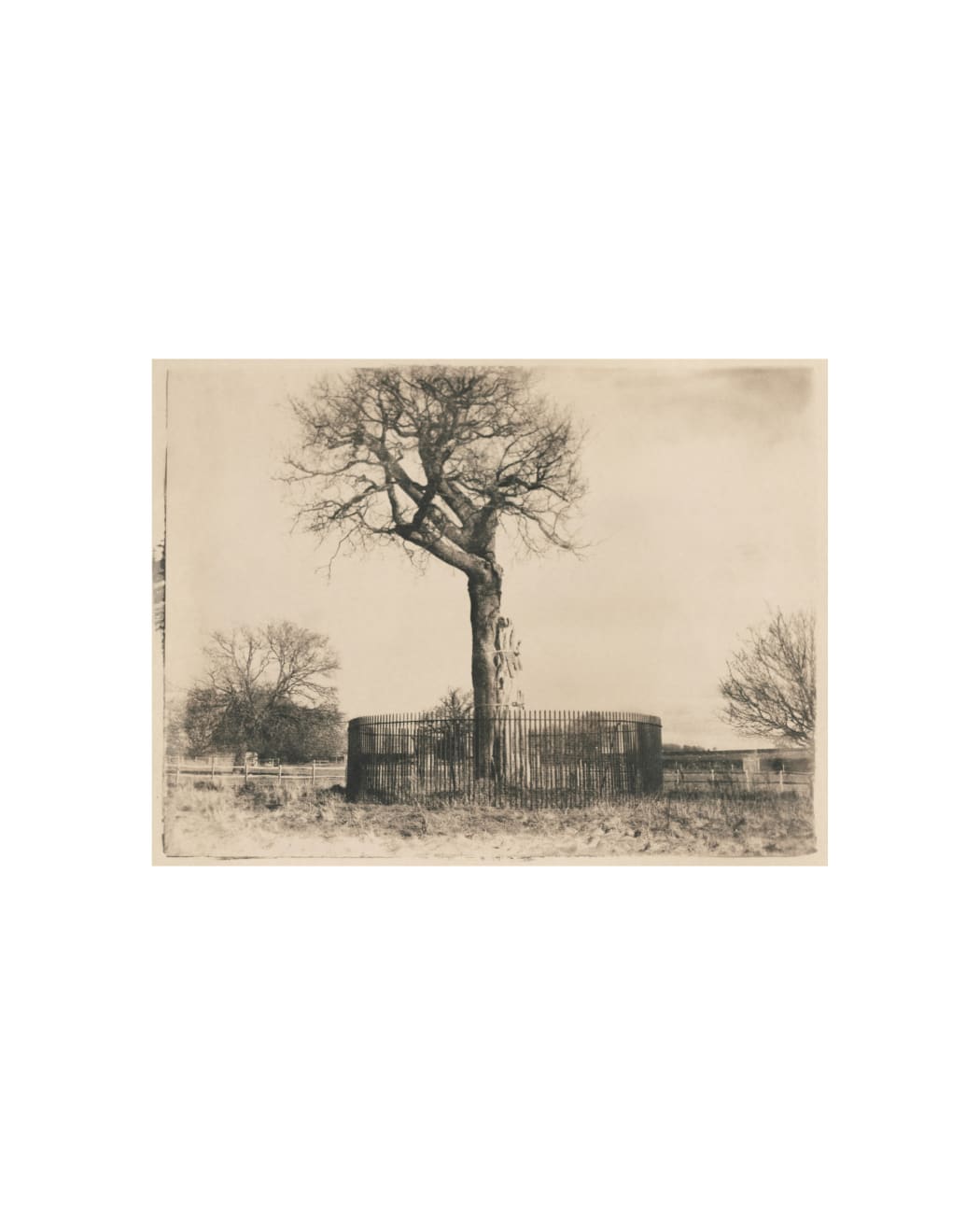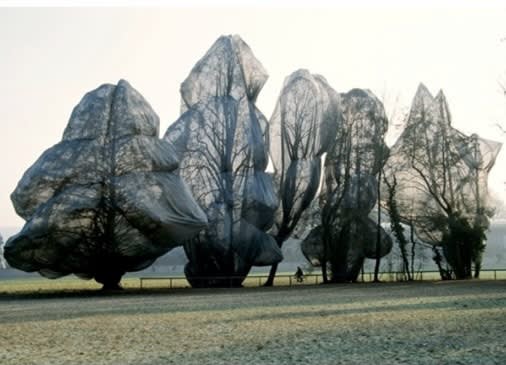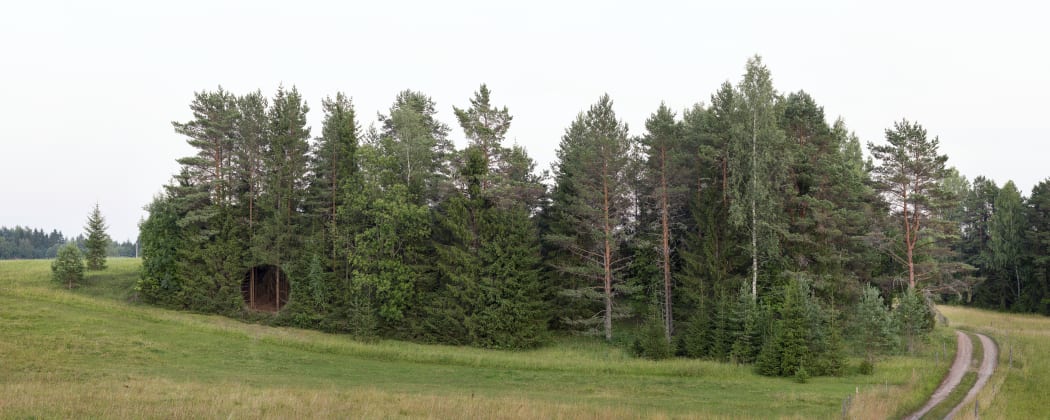-

-

Photographic Phytography by Epha J Roe
Towards a Photographic Re- Centring of the Oak Tree within Theory, Material and PracticeThis paper explores my practice-based research project Arboreal Encounters, a collection
of tannin toned cyanotypes made with six heritage oak trees that form an element of
my part-time, practice-based Ph.D. at the University of Brighton, UK. It comprises a
brief history and background of the project before exploring how photographic practice
might interact with and integrate notions of vegetal intelligence within artistic practice.
By thinking of the production of Arboreal Encounters as if an invitation to the trees to
become part of the process of their own representation, I consider how such interactions
might act symbolically as human-plant collaborations and how methods of thinking,
as well as doing, may resist notions of the plant as commodity within artistic practice.
-

-
 Christo & Jean-Claude, Trees, 1998
Christo & Jean-Claude, Trees, 1998 -

Trees Heal
How trees can heal: Research shows that patients looking at greenery from their hospital beds can cut the need for painkillers and even reduce post-op problemsRecently a friend battled pancreatic cancer in a treatment room devoid of anything but grey walls and windows locked shut so "no one jumped out." Nothing could have made her determination to get well harder work. Furthermore, all of us will spend some or a great deal of time in our lives ill or unwell. So continuing the interest in the article by Dr Miriam Dobson from NHS Forest from March last year, I am looking at more research into why Trees are so important for human health, healing and wellbeing in visual as well as actual form. What they exhale we inhale, without them we wouldn't be alive, and yet also their importance in our wellbeing doesn't stop there.
As John Naish wrote in an article in 2019; Rachel Stancliffe, a leading public health expert from Oxford, was visiting her father in a Dorset hospital after he'd suffered a stroke, when she decided to take him around the grounds in a wheelchair to help boost his morale.
But there was nowhere to escape from the complex's dismal concrete. 'There were no trees, no greenery - only a single pond that was blocked from public access,' she recalls.
The experience inspired Rachel - an epidemiologist who helped to develop the Cochrane Library, the world's leading organisation for analysing health research findings - to launch the NHS Forest, a project funded by charitable events which helps hospitals improve their environments by planting trees. Numerous scientific studies have shown that green spaces - and trees in particular - are beneficial to our physical and mental health.
Being in their presence has been found to accelerate recovery from illness and to lower stress levels.
Rachel's project was implemented first at Alder Hey Children's Hospital in Liverpool, which was redesigned as the 'hospital in the park' following building work in 2013. 'They reorientated it so that it is among plentiful green spaces,' says Rachel. 'Our aim is to make the NHS more environmentally friendly and a healthier place for patients and staff.'
'There are so many good-quality studies that show the physical and mental health benefits of green spaces and in particular trees,' says Rachel. 'Yet people can often spend months in British hospitals where they don't get to see a single tree.'
NATURE LOWERS STRESS - AND SPEEDS RECOVERY
It may seem strange to think that trees can help to heal us, but the evidence is both robust and astonishing. In 1984, pioneering investigator Dr Roger Ulrich, director of Texas A&M University's Centre for Health Systems and Design, studied the records of patients recovering from gallbladder surgery in a hospital between 1972 and 1981.
He found those whose rooms looked out on to trees recovered more quickly, suffered fewer complications and needed less pain relief than those whose rooms faced brick walls. Since then, the evidence has steadily increased, says Rachel: 'We see lower rates of asthma in children in urban areas that have lots of trees.'
'Studies also show when people's environments feature trees, their immune defences are enhanced and their levels of inflammation, blood pressure and the stress hormone cortisol are all lowered. These latter factors can contribute to heart disease and cancer.'
Sara Lom, chief executive of The Tree Council, a charity promoting the importance of trees, told Good Health: 'The direct benefits of trees to patients and staff in and around health facilities show how, all their lives, trees look after us.'
Such ideas have already been embraced in Japan, where the practice of using trees to boost health has its own name - Shinrin-yoku, or 'forest bathing'. Some Japanese hospitals have been inspired to build rooftop 'forests' where patients can relax.
A 2011 study in the Japanese Journal Of Hygiene found spending just five minutes in these areas helps patients feel calmer, more positive and more motivated to work on their recuperation. Even having bonsai trees on hospital wards can lower patients' levels of stress and their need for painkillers, according to a study published last year in 2018 the International Journal Of Environmental Research And Public Health by psychologists at Chiba University in Japan.
The researchers scanned the patients' brains and found that there was less activity in the left prefrontal cortex, an area associated with stress responses, after seeing the tiny trees.
And simply viewing photographs of trees can provide curative benefits. A study by Dr Ulrich of 160 patients recovering from heart surgery at a Swedish hospital found that patients who were positioned to see pictures of a tree-lined stream had reduced anxiety and less need for pain medication than those who looked at abstract paintings, a blank wall or a white panel.
All this research supports the 'biophilia' hypothesis - a theory introduced by psychoanalyst Erich Fromm and popularised in the 1980's by Harvard University evolutionary biologist Edward Wilson. They argued that humans have biological and psychological needs for natural stimuli.
'It is not hard to see why that should be,' says Rachel Stancliffe. 'We spent millennia evolving our sensory and bodily functions amid wooded landscapes. Since we have started living in cities, these functions have become stressed. If we get unhealthy, we may either need drugs to help our bodies to cope, or we need to rediscover the benefits of the natural environment.' We all need green spaces - but it's trees in particular that bring a special benefit, according to research published in July in the journal JAMA Network Open.
The study of more than 45,000 people's wellbeing over ten years found living near green spaces made no difference to their physical and mental health. It was only when the green spaces featured trees that benefits occurred, said the research team from the University of Wollongong in New South Wales, Australia.
An analysis of national health records by the U.S. Forest Service between 1990 and 2007 has found deaths related to cardiovascular and respiratory illnesses rose in places where trees succumbed to the pest, contributing to more than 20,000 additional deaths during the study period.
In the UK, we are suffering a national tree deficit, relative to our emissions of the greenhouse gas carbon dioxide, according to government advisers. The Committee On Climate Change recently recommended the UK plant 1.5 billion trees by 2050 to counter this.
Trees improve air quality by capturing pollutants and toxic gases. A single tree can absorb 10lb of air pollutants a year, reports the U.S. Forest Service. But some types of tree are better than others at bringing these benefits, according to Katherine Willis, a professor of biodiversity at the University of Oxford.
'Some are surprisingly efficient at improving air quality, such as the small and shrubby dwarf Korean lilac,' she told Good Health. 'The London plane tree is also very effective. It absorbs pollutants and sheds them in its bark.'
Our interest in this subject continues and we thank John Naish, Sara Lom and Rachel Stancliff for their research and the information within this article.
Emmeline Hallmark
-
 John Constable Fir Trees at Hampstead (1834) © Trustees of the Cecil Higgins Art Gallery (The Higgins Bedford)
John Constable Fir Trees at Hampstead (1834) © Trustees of the Cecil Higgins Art Gallery (The Higgins Bedford) -
 Mark Frith, Talley Abbey Ash, graphite on Fabriano paper
Mark Frith, Talley Abbey Ash, graphite on Fabriano paperWell-being on Walls
Why we all love Tree Art. The amazing positive impact Trees have on our health whether in our indoor or outdoor environment, by Dr. Miriam Dobson